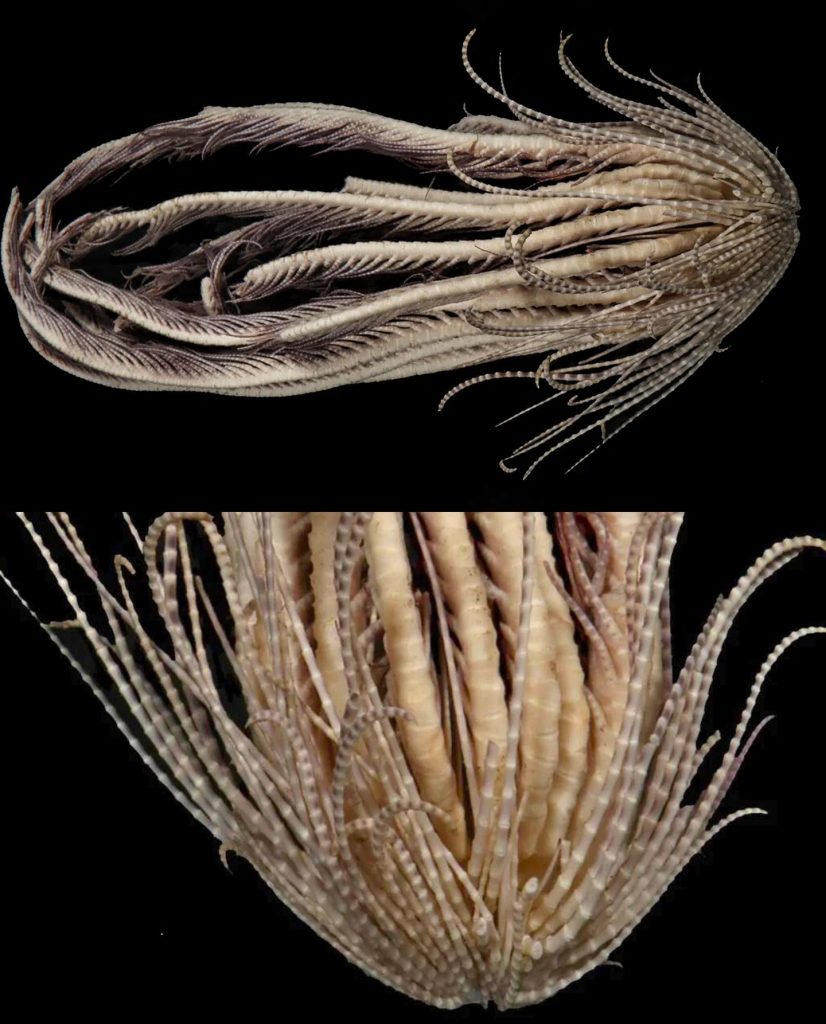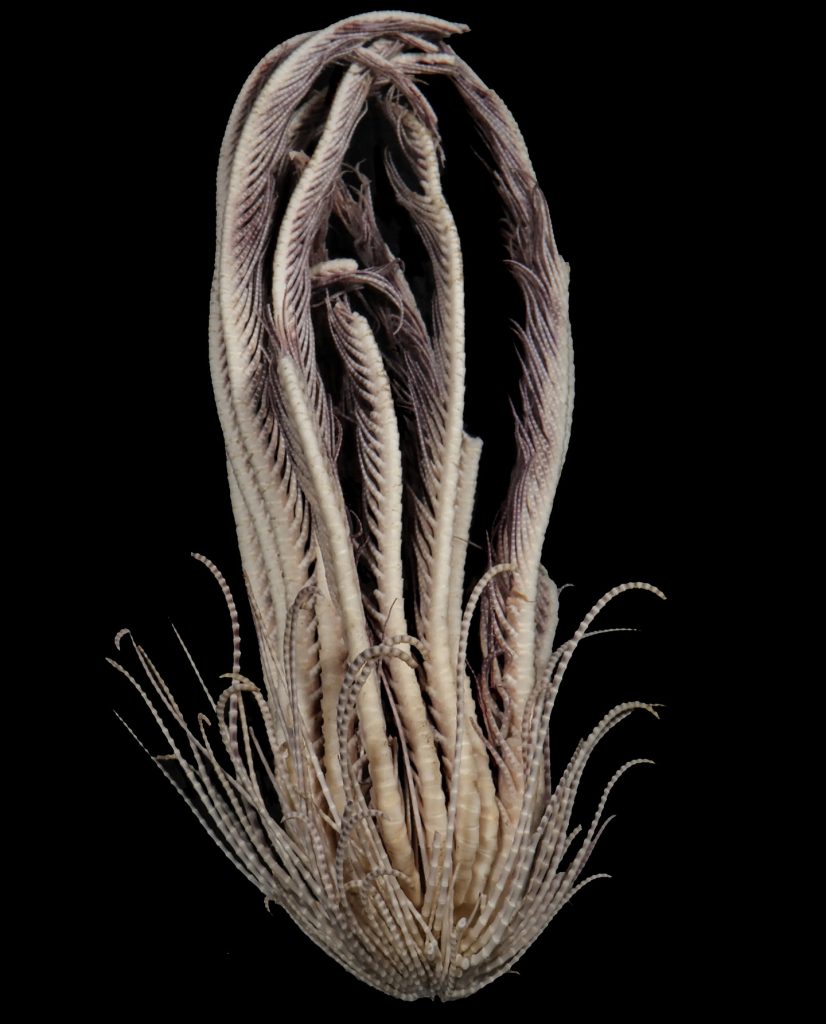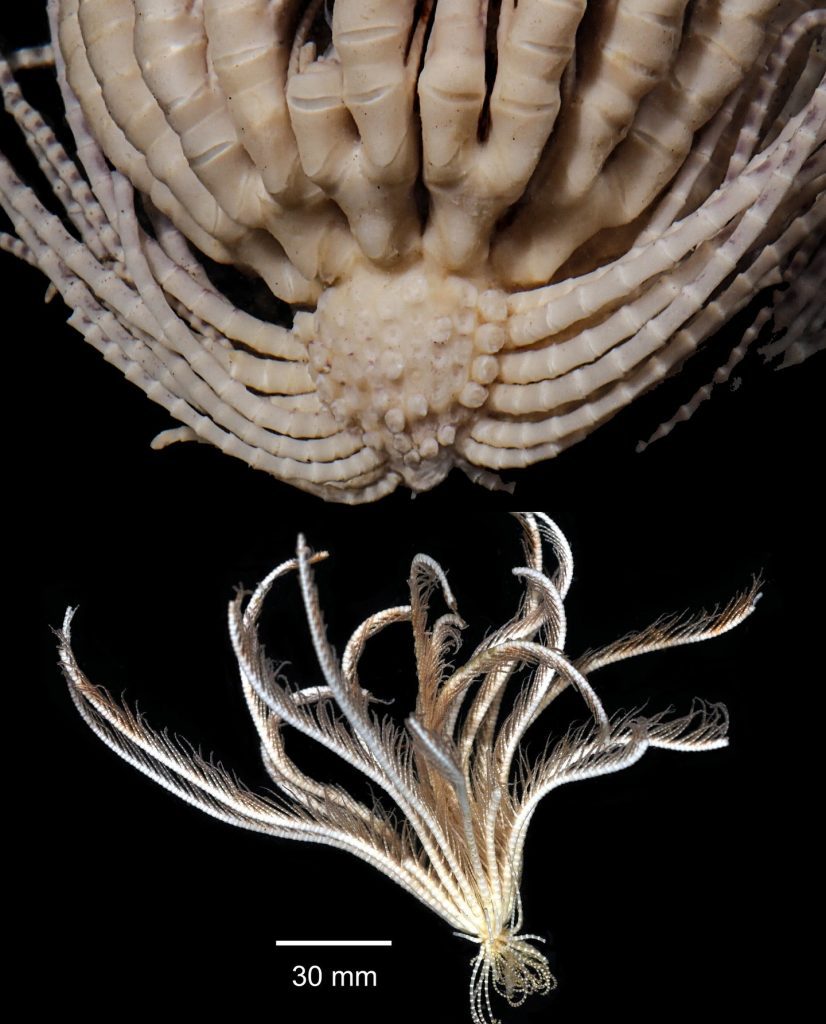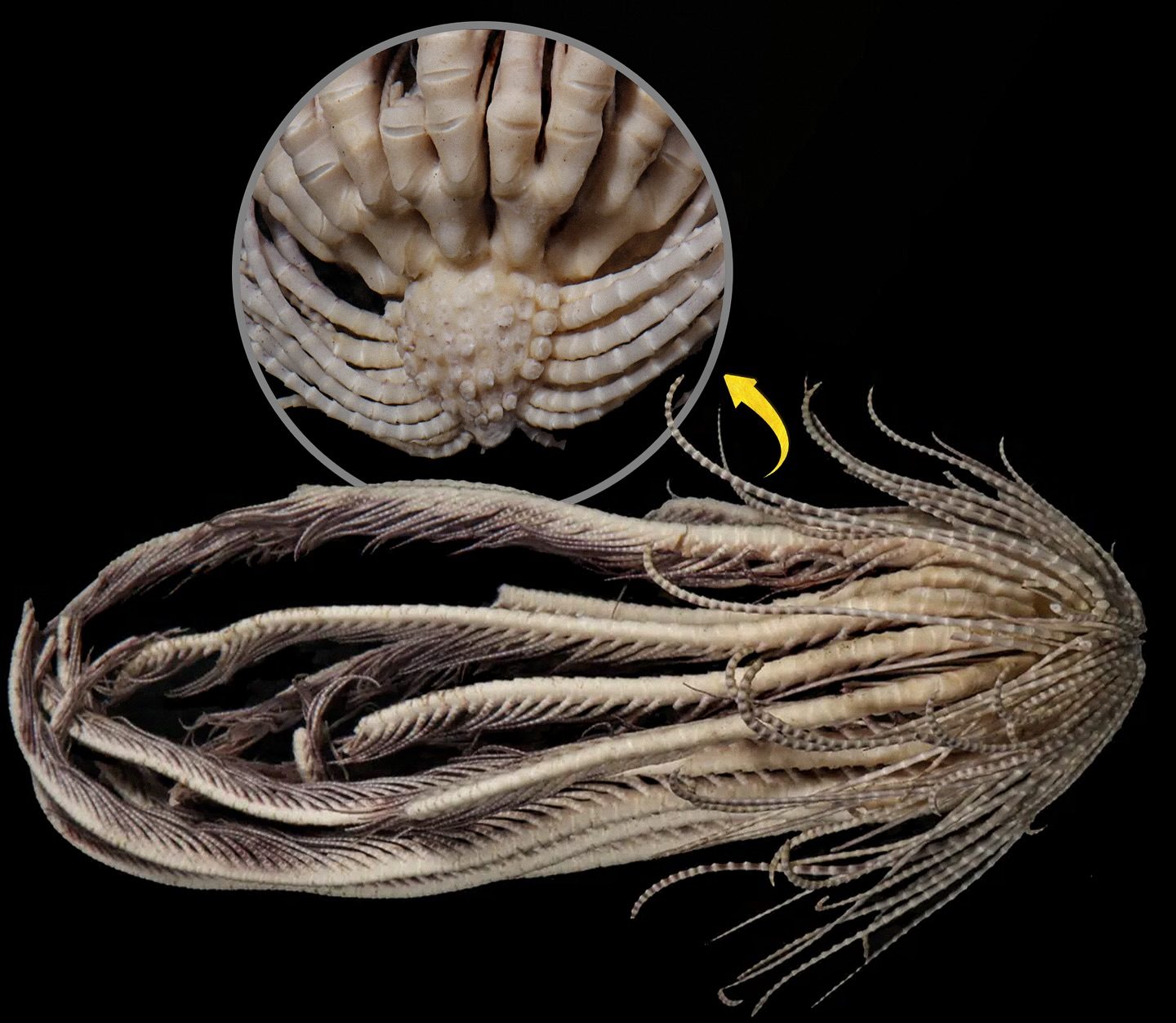SCIENTISTS DISCOVERED AN ALIEN-LIKE ANIMAL WITH 20 ARMS DEEP BENEATH THE ANTARCTIC ICE

I didn’t expect wonder to arrive looking like a tassel of pale ribbons, but that’s exactly what appeared on my screen the first time I watched video of the Antarctic strawberry feather star. It looked almost unreal—like a delicate prop from a sci-fi set that slipped into the real world and decided to swim. Then I learned it wasn’t movie magic at all. It was a newly described creature from the edge of the map, living in water so cold it stings the lungs just to imagine breathing it, and I fell headfirst into the story the way those feathery arms fall into the current. Scientists have given it a formal name—Promachocrinus fragarius—but the nickname tells you everything you need to know: strawberry feather star. The center of its body, called the centrodorsal, is studded with little bumps that evoke a strawberry’s seeds, while twenty arms plume outward like living fronds. The whole animal swims by waving those arms, drifting and gliding in slow motion, like a piece of cosmic sea-lace come to life.
What grabbed me wasn’t just the look—it was the timing. This isn’t a Victorian tale of a sailor bringing home a strange specimen in a pickle jar. This happened now, in our time, when we carry more computing power in a pocket than past explorers had on their entire ships. In 2023, a team of researchers untangled the taxonomy of Antarctic feather stars and realized that what many thought was one species was actually a hidden cluster, with the most eye-catching member being this strawberry-bodied swimmer with twenty arms. It’s a reminder that even in a hyper-mapped world, the unknown still stretches right beneath the ice.
A glimpse under the ice

I keep thinking about where it lives. These animals haunt the Southern Ocean around Antarctica, inhabiting depths that, translated to land-lover terms, are like stacking three Empire State Buildings and sending them straight down. Reports from the team describe the species at roughly 65 to 1,170 meters below the surface—about 213 to 3,840 feet—where the water is dim, the currents are powerful, and winter never ends. Some specimens were associated with areas around the remote South Sandwich Islands, a chain so far from the rest of us that it feels like the Earth’s last whisper before the open roar of the Southern Ocean.
Down there, life runs on patience. The strawberry feather star finds a perch, extends its arms, and faces the flow. Along those arms are tiny structures and tube feet that catch plankton and organic flecks drifting by, a living net spread open to the sea. When the buffet slows, it doesn’t march like a crab or dart like a fish; it swims, rising off the bottom and rowing itself to a new patch of current with calm, eerie grace. Watch it long enough and you start to understand that speed isn’t the only way to be powerful in the ocean. Sometimes power looks like poise.
Color surprises me too. Notes from the work and museum images show individuals shaded anywhere from purplish to dark reddish, as if the animal borrowed pigments from the Antarctic twilight. That palette, combined with the starburst of arms and the bumpy “strawberry” center, creates a look photographers call otherworldly. But “otherworldly” can be misleading. This world is exactly where it evolved to live, under pressures and temperatures that would buckle our bodies in a heartbeat, where even light has to negotiate with the sea to make it this far.
The strawberry feather star belongs to the crinoids, which are echinoderms—the same broad family as sea stars and sea urchins. But unlike the familiar five-armed stars in picture books, many crinoids perch and filter the water for a living, and some, like this species, are free-swimming and stemless. It carries twenty arms, but that number is only part of the story. In addition to the main arms, it bristles with cirri—flexible, claw-tipped appendages used for anchoring and crawling—which help give that “strawberry” center its signature texture. I love that detail because it’s both poetic and practical: the nickname may sound whimsical, but it’s rooted in something real that you can point to under a microscope.
The creature’s debut also corrected a long-standing mistake. For years, many Antarctic feather stars were all lumped under a single species label. The 2023 revision split that tangle into several species, eight in total, with six of them bearing twenty arms and two with ten. The strawberry feather star became the headline because it looks like it belongs in a dream sequence, but the real miracle is how much careful work sits behind that reveal: research vessels braving rough seas to collect samples, taxonomists spending months with morphology and genetics, and the patience to compare tiny differences until a clearer map of life emerges. Science is often less eureka and more endurance.
When I show friends the photos, the first question is always the same: is it safe to be near? I laugh, because the strawberry feather star is not a monster. It’s a filter feeder built for plankton and marine snow, not for us. If anything, we’re the unpredictable species in this relationship. The Southern Ocean is warming and freshening as ice melts, shifting the currents that ferry larvae and nutrients. The distribution of feather stars depends on those currents. If currents change, life patterns change. The strawberry feather star may look alien, but it is exquisitely tuned to the planet we all share, and the future we’re making will touch its world too.
I picture the shipboard moment the researchers first saw one unfurl on a tray. Wind scouring the deck. The net rising silver with spray. On the sorting table, amid rough textures of shell and stone, something intricate and pale loosens its arms and starts to move. That’s the kind of memory that keeps people going back to sea. It explains the bruises and the chilled fingers and the nights spent labeling jars by the hum of the generator. There’s joy in seeing the world unveil itself, even a small piece of it, and writing down its name so we don’t forget.
Why this discovery matters

It matters because discovery resets our sense of scale. It reminds us that the ocean is still writing chapters we haven’t read. When people say “we’ve seen it all,” they’re thinking about beaches and piers and snorkeling depth. The reality is that most of the ocean is dark, cold, and hard to reach. Each time a trawl or camera drops, it’s like pulling back a curtain on a stage we’ve barely illuminated. The strawberry feather star, with its twenty traveling arms, becomes a messenger from that stage, telling us that complexity thrives in places we rarely imagine.
It also matters because taxonomy—the unglamorous craft of naming and sorting—anchors every other action we take. You can’t protect what you haven’t described. You can’t measure change in a species you can’t recognize. The work that split a single “feather star” into several species doesn’t just satisfy curiosity; it builds the foundation for conservation and for understanding how Antarctic ecosystems respond to stress. In a world asking big questions about climate, fisheries, and polar change, those details aren’t minor. They’re the steering wheel.
There’s a more personal reason too. I’m drawn to stories where beauty sneaks up on you. This animal lacks the familiar symmetry that makes dolphins and penguins poster stars. It doesn’t have eyes to meet or a smile to project. But in quiet motion, it becomes mesmerizing—twenty arms unfurling like a soft chandelier, then closing again when the moment passes. The longer I look, the more it looks back, not with a face but with form. It’s a kind of humility course. The planet’s art direction doesn’t need our approval to be breathtaking.
Think about time, as well. Crinoids have an ancient lineage; their fossils stud rocks laid down long before humans were here to admire them. The strawberry feather star is a modern thread woven into that deep history, a living continuation of a pattern that has survived mass extinctions and plate shifts and ice ages. When we find a species like this, it isn’t the start of its story—it’s our first sentence. We meet it mid-plot, in the chapter that happens to overlap with our lives, and our responsibility is to keep the book from closing.
I like to imagine the future scene too: a classroom of kids watching a short clip of this animal gliding through dim blue water, a teacher pausing to ask what they notice. Someone will point out the arms, someone the color, and someone—the kid who always looks for how things work—will notice the way it faces the current. That small observation will plant a seed. Maybe it grows into a career. Maybe it just grows into a habit of looking closer. Either outcome is a win for the ocean.
If you ever need a little wonder, search up the footage and let yourself watch without hurry. Watch the way the arms curl and spread in the water, each lined with finer filaments, each designed to make a living out of what the current brings. Think how many times the ocean has performed this choreography unseen. Think how lucky we are to be here right now, when new things are still being found—when we can say strawberry feather star and mean it. And if you feel a twinge of hope at that, hold on to it. Hope is a current too. It moves us to look closer, to learn the names, to protect what we’ve found.
In the end, the Antarctic strawberry feather star isn’t alien at all. It’s an emissary from our own ocean, proof that life keeps inventing forms we haven’t dreamed up yet. Twenty arms in a place that’s almost never warm, a strawberry-textured center built for grip, a life written in the language of currents. The photos are arresting, but the idea is better: the world is bigger than our habits, and it still has surprises for anyone willing to look beneath the ice.

